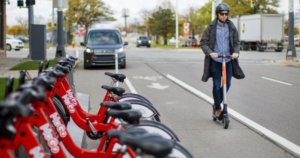As urban landscapes evolve and embrace sustainable mobility solutions, electric scooters have emerged as a popular choice for eco-conscious commuters.
One of the key factors influencing the adoption of electric scooters is their range – the distance a scooter can cover on a single charge.
In this article, we will delve into the factors that affect electric scooter range and explore ways to maximize efficiency.
Understanding Electric Scooter Range
Electric scooter range is determined by the capacity of its battery and the efficiency of its electric motor.
The battery’s capacity is measured in kilowatt-hours (kWh), and the higher the capacity, the longer the scooter can travel on a single charge.
Additionally, the efficiency of the electric motor, measured in terms of energy consumption per mile or kilometer, plays a crucial role in determining the scooter’s range.
Factors Influencing Range
- Battery Technology: Advances in battery technology directly impact electric scooter range. Lithium-ion batteries, commonly used in electric scooters, have seen significant improvements in energy density, allowing for longer rides between charges.
- Terrain and Riding Conditions: The terrain on which the scooter is ridden affects its energy consumption. Hilly terrains demand more power, reducing the scooter’s range. Similarly, constant acceleration and braking in stop-and-go traffic can impact efficiency.
- Rider Weight: The weight of the rider can influence the scooter’s performance. Heavier riders may experience a slightly shorter range compared to lighter individuals.
- Weather Conditions: Extreme temperatures, especially very cold weather, can impact battery performance and reduce range. It’s essential to consider weather conditions when estimating the scooter’s range.
- Speed: Riding at higher speeds consumes more energy. Maintaining a moderate speed can help maximize the scooter’s range.
Maximizing Electric Scooter Efficiency
- Regular Maintenance: Keeping the scooter well-maintained ensures optimal performance. Regularly check tire pressure, lubricate moving parts, and ensure that the brakes are in good condition.
- Smart Riding Habits: Adopting eco-friendly riding habits, such as smooth acceleration and deceleration, can contribute to increased efficiency and a longer range.
- Optimal Charging Practices: Following the manufacturer’s recommendations for charging and avoiding deep discharges can prolong the battery life and maintain consistent performance.
Conclusion
Electric scooters are at the forefront of sustainable urban transportation, offering a clean and efficient alternative to traditional modes of commuting.
Understanding the factors influencing range and adopting smart riding practices can enhance the overall efficiency of electric scooters, making them a viable and eco-friendly choice for urban dwellers.
As technology continues to advance, we can expect further improvements in electric scooter range, contributing to a greener and more sustainable future.



